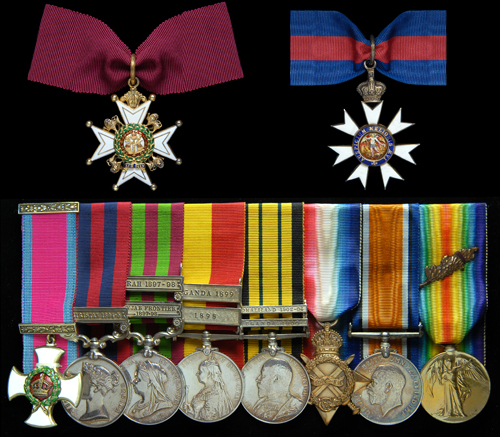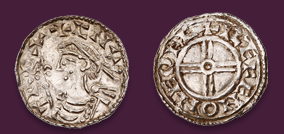
Auction: 8010 - Orders, Decorations, Medals & Militaria
Lot: 108
The Suberb and Rare C.B., Great War C.M.G., ´Waziristan, 1894, Wana´ D.S.O. Group of Ten to Brigadier-General M.L. Hornby, York and Lancaster Regiment, Late Uganda Rifles and Indian Army, Wounded During the Fanatical Waziris Attack on Turner´s Camp at Wana; Commanded a Column in the Operations Against the Nandi Tribes, 1900, For Which He Was Mentioned in Despatches; Commanded the 8th Battalion of His Regiment During the Great War, When He Was Mentioned in Despatches a Further Five Times, and Received Another Wound a) The Most Honourable Order of the Bath, Military Division, Companion´s (C.B.), neck Badge, silver-gilt and enamel b) The Most Distinguished Order of St. Michael and George, Companion´s (C.M.G.), neck Badge, silver-gilt and enamel, minor enamel damage c) Distinguished Service Order, V.R., silver-gilt and enamel, with integral top riband bar d) India General Service 1854-95, one clasp, Waziristan 1894-95 (Lieutt. M.L. Hornby 2d. Punjab. Infy.) e) India General Service 1895-1902, V.R., two clasps, Punjab Frontier 1897-98, Tirah 1897-98 (Lieut. M.L. Hornby 2d. Punjab. Infy.) f) East and Central Africa 1897-98, two clasps, 1898, Uganda 1899 (Lt. M.L. Hornby. 1/Uganda Rif:) g) Africa General Service 1902-56, E.VII.R., two clasps, Uganda 1900, Somaliland 1902-04 (Capt: M.L. Hornby, D.S.O. I.S.C.) h) 1914-15 Star (Lt. Col. M.L. Hornby. D.S.O. York. & Lanc. R.) i) British War and Victory Medals, M.I.D. Oakleaves (Brig. Gen. M.L. Hornby), generally good very fine, last eight mounted for display (10) Estimate £ 4,500-5,000 C.B. London Gazette 31.12.1921 Colonel Montague Leyland Hornby, C.M.G., D.S.O., Brigade Commander, Lancashire Fusiliers Infantry Brigade, Western Command. C.M.G. London Gazette 4.6.1917 Maj. & Bt. Lt.-Col (temp. Brig.-Gen.) Montague Leyland Hornby, D.S.O., ret. pay, Ind. Army. D.S.O. London Gazette 27.8.1895 Lieutenant Montague Leyland Hornby, Indian Staff Corps ´´In recognition of services... during the recent operations in Waziristan.´´ Brigadier-General Montague Leyland Hornby, C.B., C.M.G., D.S.O. (1870-1948), educated at Shrewsbury School and Royal Military Academy Sandhurst; commissioned Ensign East Lancashire Regiment, 1889; appointed Lieutenant Indian (Bombay) Staff Corps, 1892; served as the Orderly Officer to the General Officer Commanding Waziristan Delimitation Escort (Brigadier-General A.H. Turner), 1894, including action at Wana where Hornby was wounded, he was later awarded the D.S.O. for his bravery during the attack on the attack on the camp; Turner´´s force consisted of approximately 2,817 men including a squadron of the 1st Punjab Cavalry, men of the: 1st Gurkhas; 3rd Regiment of Sikh Infantry; 20th Bengal Infantry; supported by No. 3 (Peshawar) Mountain Battery and No. 2 Company Bengal Sappers and Miners. Turner´´s despatches relating to the operations of the force under his command from the 1st October to 29th November 1894, including the attack on his camp at Wana (3.11.1894) gives more incite into the action and indeed the part played by Hornby. On the 11th, 12th and 13th October 1894 Turner´´s brigade moved out of its base at Dera Ismail Khan in three detachments to form up again at Kajuri Kach on the 18th, where they were also joined by members of the Delimitation Commission. After several reconnaissances of the surrounding area had been carried out, Turner ordered his troops to march from Kajuri Kach to Wana via Spin and Karab Kot. They arrived at Wana on the 24th, ´´Wano [sic] is a large open plain, for the most part stony, about 13 miles long by 11 miles broad. The only running stream is the Toi which skirts the southern and south eastern edge of the plain, and along the banks of which there is a narrow strip of cultivation surrounding the villages and forts of the Ahmadzai Darweshkhel Waziris... From the time the troops reached Wano [sic] it was apparent that individual Waziris were bent on mischief, and the camp was fired into nightly, a Naik of the 1st Gurkhas being severely wounded on the 25th October. On the evening of the 28th, the Commissioner informed me that a gathering of some 800 Mahsud Waziris, under the leadership of a fanatical Mulla named Powindah, were reported to have collected at Kaniguram and were about to move into the Khainar Valley, where they might possibly be increased to 1,000 or 2,000 men... On the 1st November the report of the arrival of Mulla Powindah at Kaniguram was confirmed, and on the 2nd news was received that he, with a following of about 1,000 men, had moved into Khaisara... The night passed quietly until 5.30 on the morning of the 3rd when the whole camp was suddenly aroused by hearing 3 shots followed by wild yells and the beating of drums and at the same instant a desperate rush of some 500 determined fanatics supported by a heavy fire from the right front was made straight into the left flank and left rear of camp. So rapid was the rush that before the Gurkhas, although already accoutred, could get out of their tents, the leading men had penetrated into their camp and so 30 of them had passed beyond into the rear of the field hospitals, Commissariat and Cavalry. The Gurkhas, though thus taken by surprise, and getting out of their tents only to find their camp in possession of the enemy, quickly formed rallying bodies and engaged in a desperate hand-to-hand conflict with the enemy, but so dark was the night that friend was undistinguishable from foe at even two or three paces distance.´´ The Waziris, whipped into a religious frenzy by Powindah, wreaked havoc in the Field Hospital and the Commissariat, ´´where they succeeded in inflicting much damage on the unarmed followers and transport animals. Some of these men, joined by others who had penetrated down the main street, succeeded in reaching the cavalry lines and even as far as the brigade staff tents. Those in the cavalry lines set to work hacking at the heel ropes of the troop with the apparent object of causing a stampede. A number of horses were thus set free and galloped out of camp... In the meantime the Gurkhas had stopped the main rush from passing down the centre street. The reserve of the regiment under Major Robinson formed a rallying square in the centre of their camp and fought back-to-back and hand-to-hand. The camp was eventually cleared at the point of a bayonet, the Waziris leaving 40 men killed behind. After the main attack had been repulsed, the tribesmen rallied for two further attacks before they were beaten off and forced to flee, orders were given for the guns to fire star shell to light up the ground where the enemy were collected, and this enabled the infantry to get in several effective volleys. There still remained a few stray men in the centre of the camp, who, while the fighting was going on, had employed themselves in looting whatever they could lay their hands on. These, finding their friends had failed to hold their ground, turned thoughts to flight. Several were shot down while attempting to flee... At 6am, when day was beginning to dawn, the enemy´´s fire slackened, and it was apparent that their retreat had commenced. I [Turner] at once sent orders for the cavalry to start in pursuit, and inflict as much damage as possible.´´ A Squadron of approximately 61 men pursued the enemy for several miles inflicting heavy casualties, until the terrain forced them to give up the chase, ´´Our losses during the attack and in the pursuit... amounted altogether 45 killed and 75 wounded, including camp-followers. Of British Officers, Lieutenant Macaulay, R.E., was killed, and the following wounded: Of the Staff, Lieutenant M.L. Hornby, Orderly Officer, severely... The enemy´´s loss was large, 125 bodies were counted in the immediate neighbourhood of camp, and many others were seen along the road traversed by the pursuing column. During the pursuit itself the cavalry killed some 50, wounded many more, and the infantry accounted for about 25. From information subsequently received, the British Commissioner estimated the enemy´´s killed at 350... It is difficult to estimate the number of the enemy engaged, but from the reports since received, I hardly think this could have been less than 3,000.´´ Hornby is further mentioned as distinguishing himself during the attack on the camp, despite being wounded. After a period of recovery Hornby was back in action in India once again, serving in Tirah, including operations in the Bara Valley, 7th-14th December 1897. From here he was posted to British East Africa the following year as Adjutant and Quartermaster 1st Battalion Uganda Rifles in the operations against the Ogaden Somalis. Hornby continued to serve in this capacity, with the added responsibilities of being the Transport and Signalling Officer to the force in Uganda 1899, and in operations against mutineers and rebels in Unyoro - including the defeat of Kabarega. As a newly promoted Captain, Hornby commanded No. 1 Column in operations against the Nandi Tribes, for which he was mentioned in Lieutenant-Colonel Evatt´´s despatch, dated December 1900, Fort Ternan (London Gazette 10.9.1901), ´´Captain M.L. Hornby, D.S.O., 1st Bn. (Ind. Conting.) Uganda Rifles, whose unfailing energy and absolute reliability on all occasions contributed greatly to such success as has been attained, relieved me of much anxiety.´´ Hornby stayed in Somaliland, this time as Chief Transport Officer for the Berbera and Obbia Forces, 1902-03 (M.I.D. London Gazette 2.9.1904; Brevet of Major). He served as Base Commandant of the Somaliland Field Force 16th July - 2nd August 1903, before being posted as Staff Officer (with local rank of Lieutenant-Colonel) to the Commander- in - Chief in Somaliland, 22.6.1904-31.3.1907. After a brief period of retirement Hornby re-engaged for service in the Great War as Brigade Major 70th Brigade, 1914-15. He was posted as Commanding Officer (Temp. Lt. Col.) 8th (Service) Battalion York and Lancaster Regiment, 1915-16; Brigade Commander 116th Infantry Brigade British Expeditionary Force and British Armies in France, 14.4.1916-13.4.1918 and 21.10-10.11.1918 (wounded; C.M.G.; M.I.D. London Gazette 15.6.1916; 4.1.1917; 15.5.1917; 11.12.1917; 20.5.1918; Brevets of Lieutenant-Colonel and Colonel); Brigade Commander 137th Infantry Brigade British Armies in France from 11.11.1918; Colonel, Commanding Officer, Lancashire Fusiliers Brigade of the Territorial Force, 1920; Appointed C.B., 1921.
Sold for
£7,800




